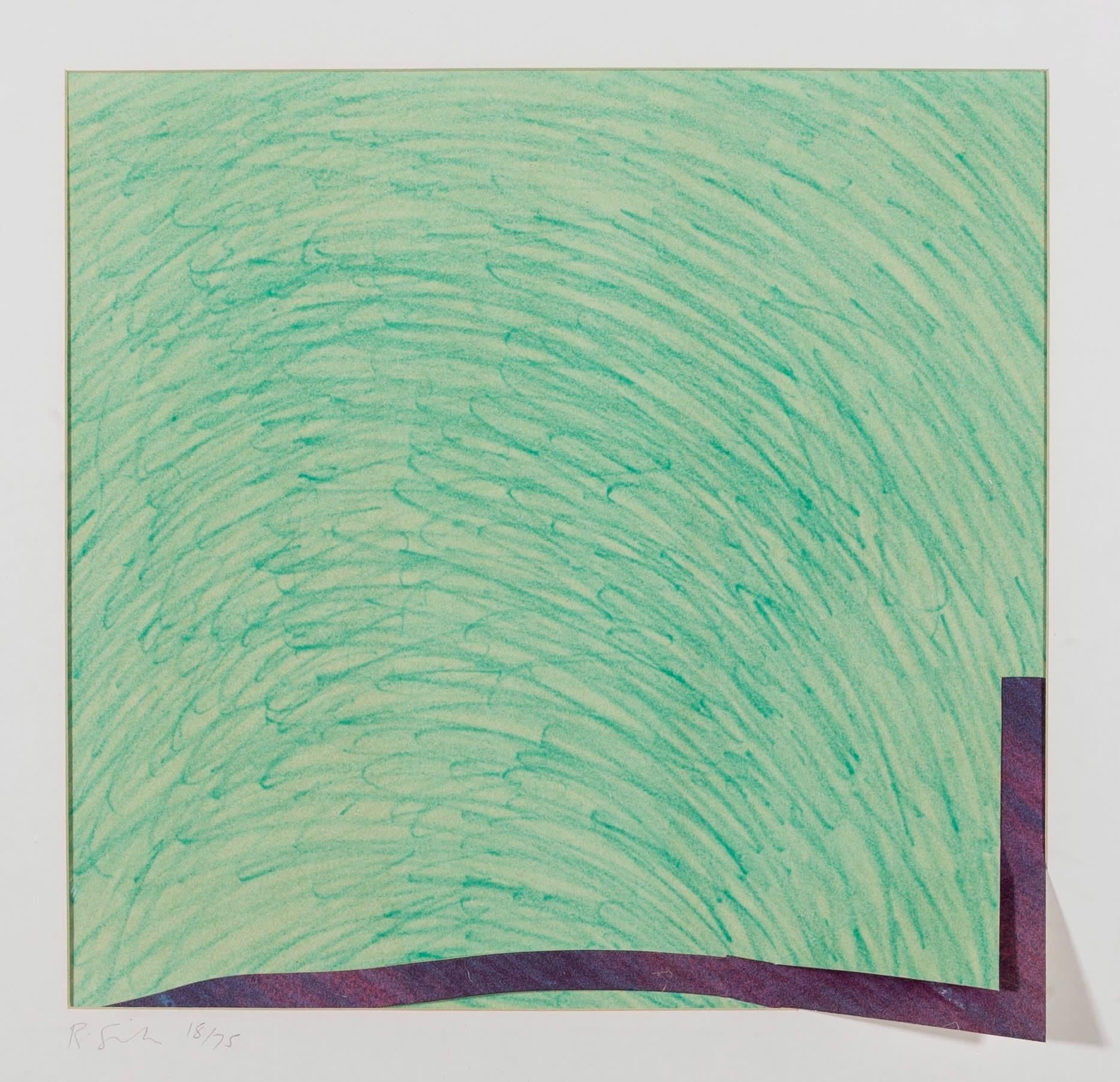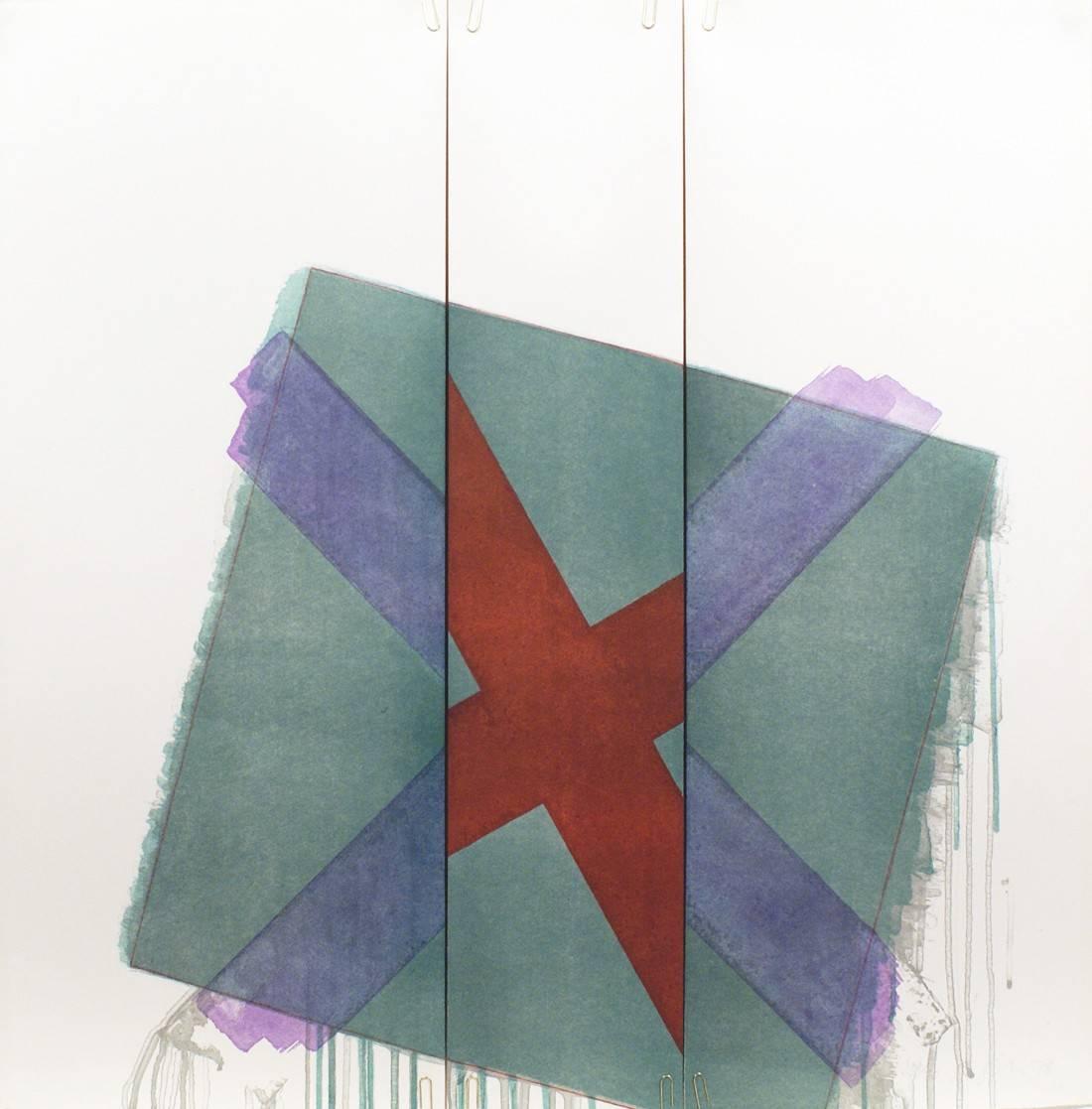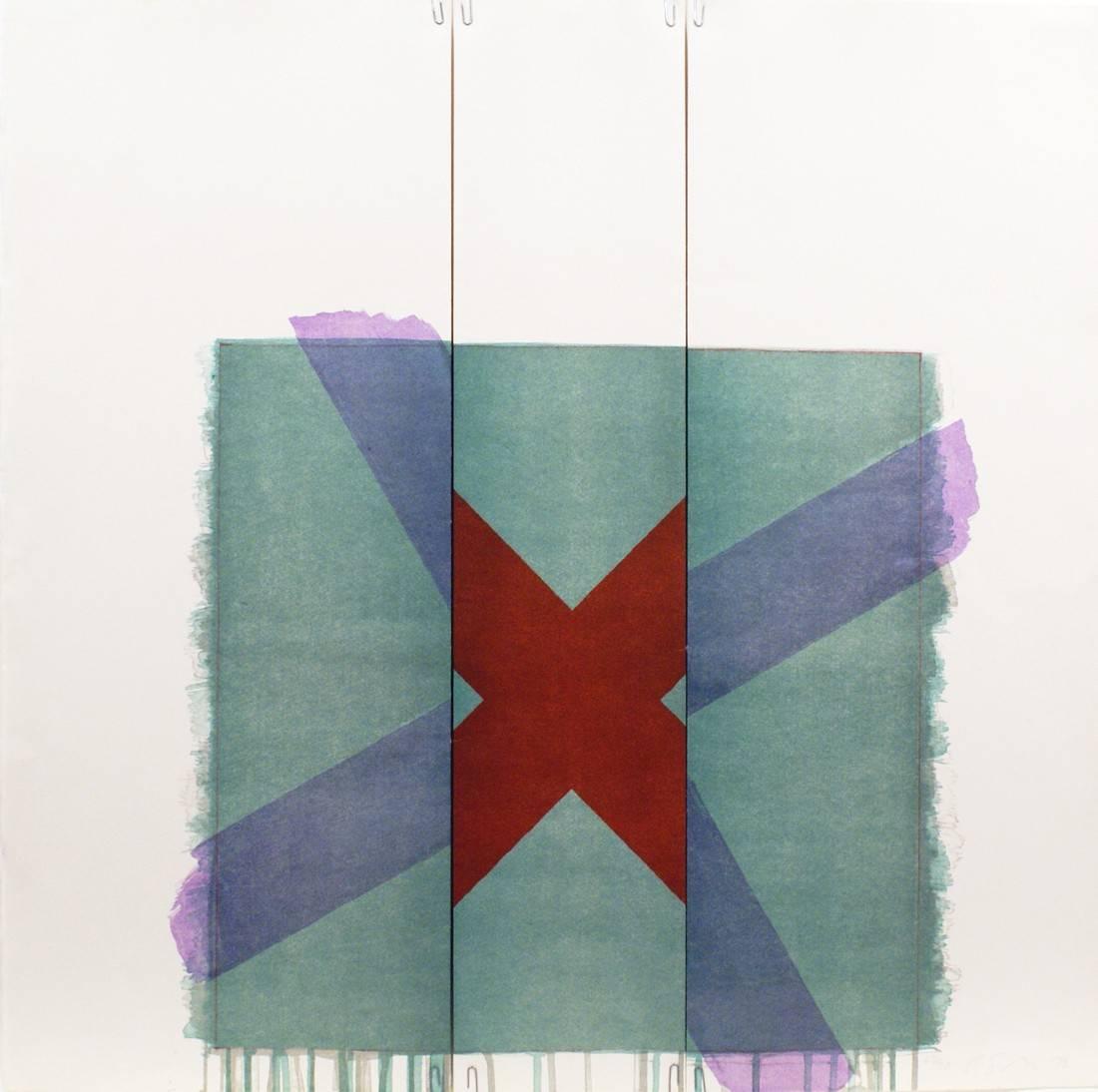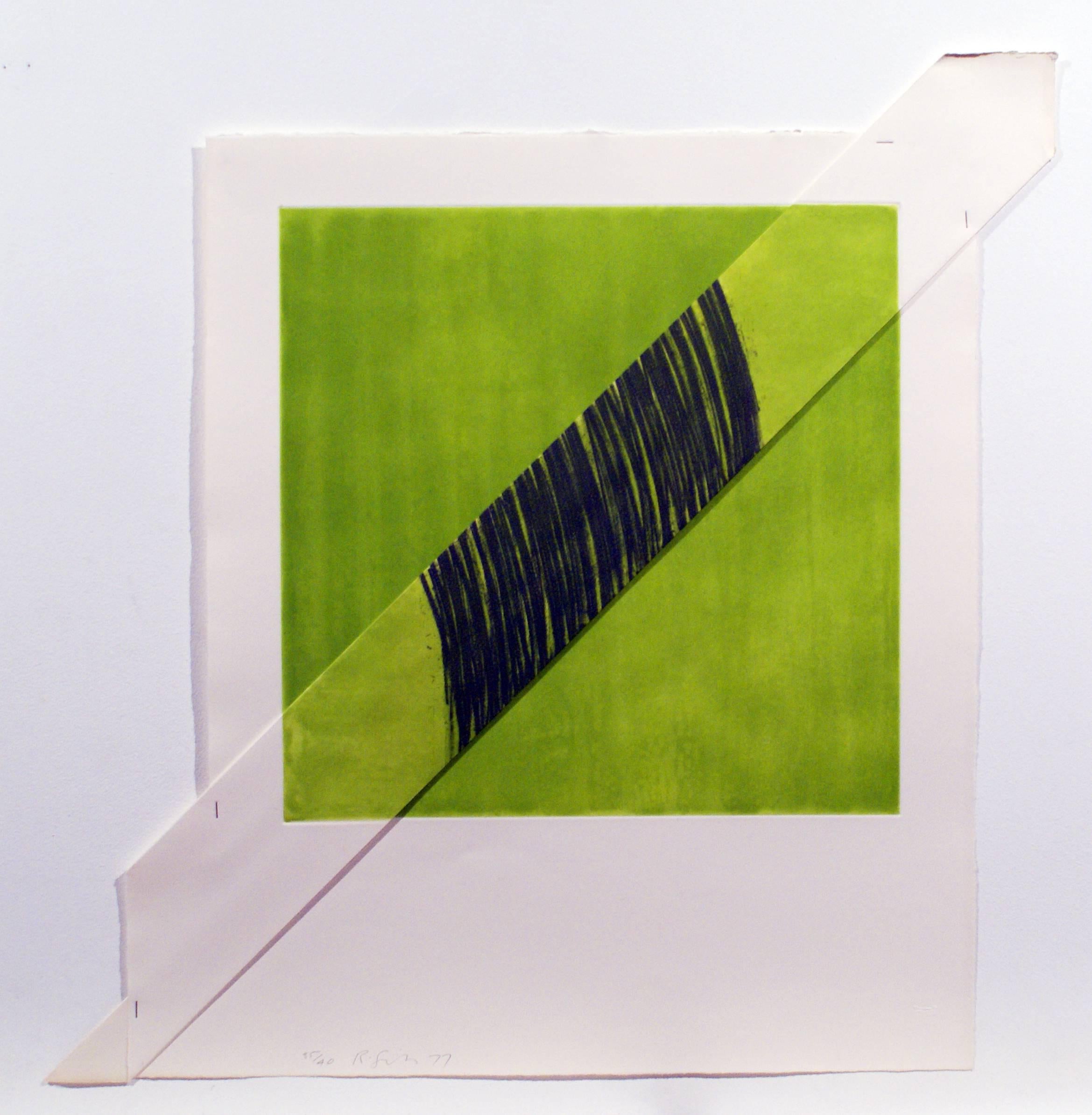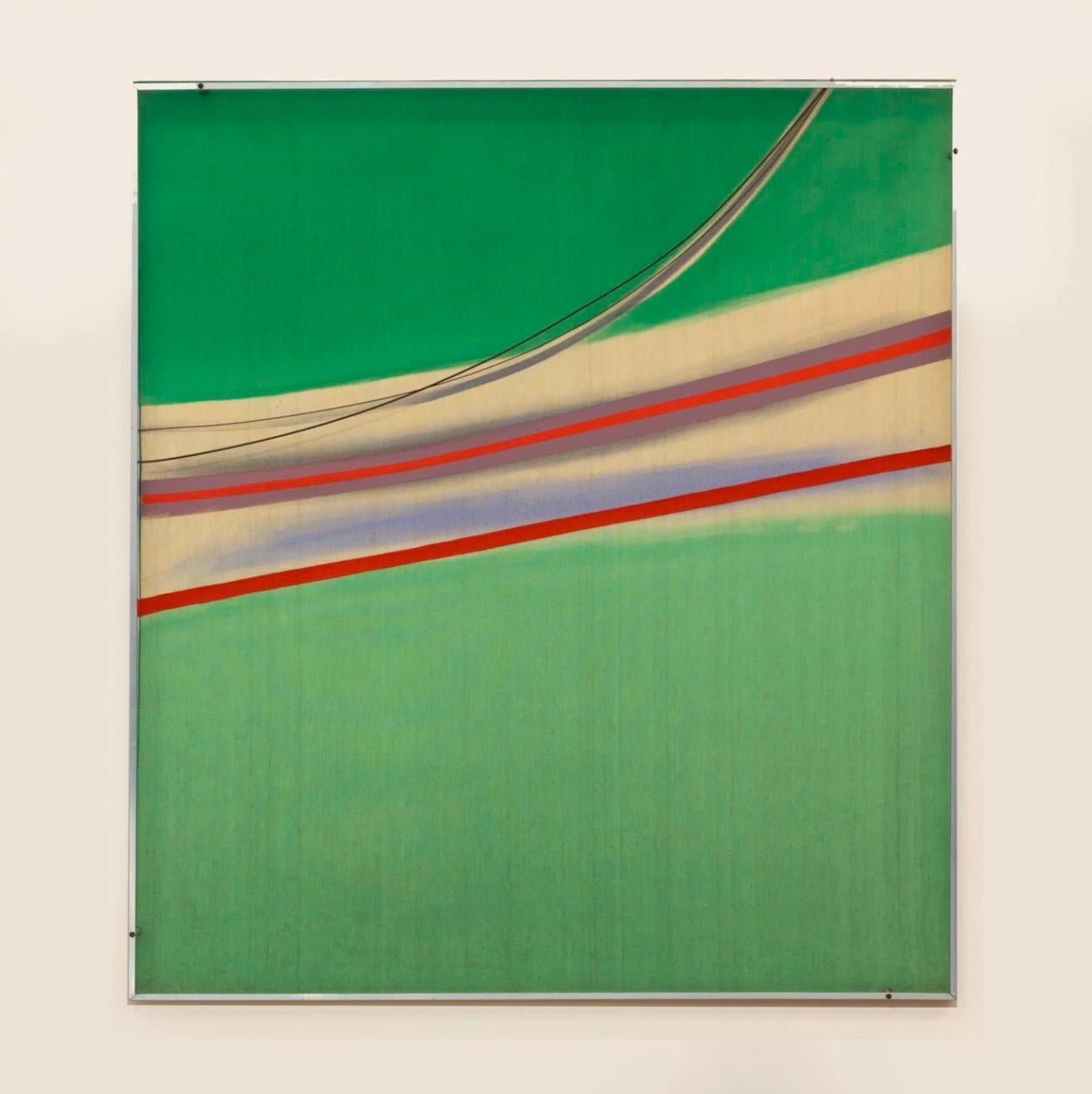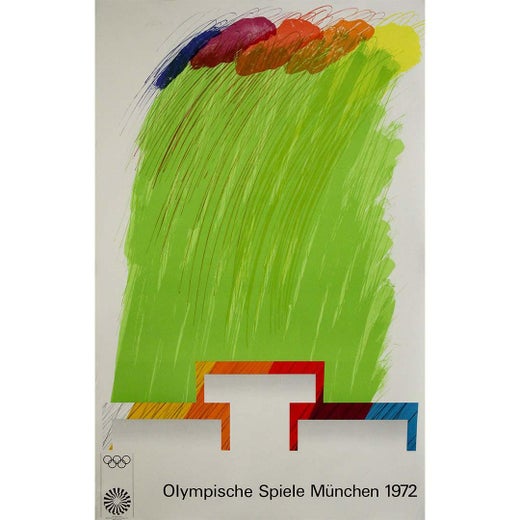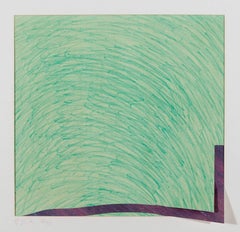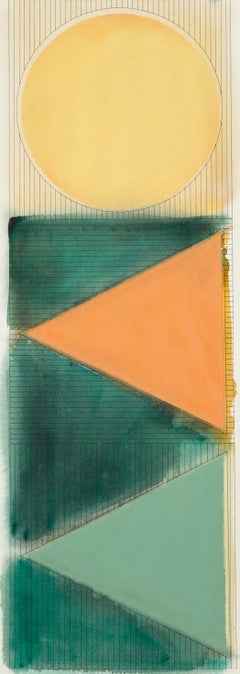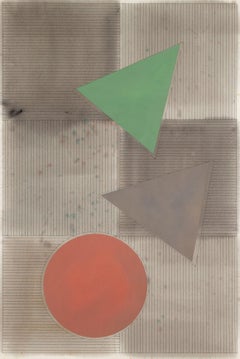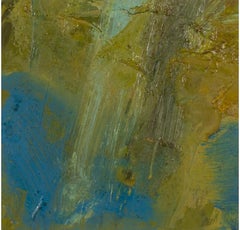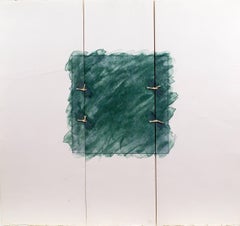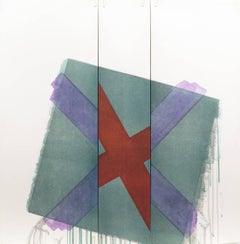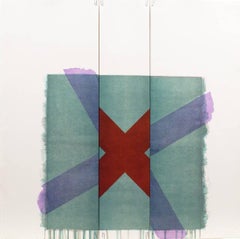Items Similar to Drawing (Green with Three Tongues) Pastel on Cutout Paper by Richard Smith, 1970
Want more images or videos?
Request additional images or videos from the seller
1 of 5
Richard SmithDrawing (Green with Three Tongues) Pastel on Cutout Paper by Richard Smith, 19701970
1970
Price Upon Request
Price Upon Request
Price Upon Request
Price Upon Request
Price Upon Request
Price Upon Request
Price Upon Request
Price Upon Request
Price Upon Request
Price Upon Request
About the Item
Drawing (Green with Three Tongues), Pastel on CutOut Paper by Richard Smith, 1970
Additional information:
Medium: Pastel on Cut-out Paper with Staples
99 x 143 cm
39 x 56 1/4 in
Signed and dated
Smith was a key figure in the British development of Pop Art. By 1970 when this work was executed, Smith was primarily concerned with the examination of the two-dimensional nature of painting and was experimenting in both his oils and his works on paper with extending the paint surface out into a three-dimensional space. In this work we see the added extensions in collage (the ‘three tongues’) to the normal rectangular format. The large scale is testament to the influence of advertising in Smith's late 60s and early 70s works. This work was made in the same year that Richard Smith represented Great Britain at the XXXV Venice Biennale, with a solo show in the British Pavilion. Smith was chosen by a committee of art experts, who were Director of Tate Norman Reid, art historian Alan Bowness, art collector David Thompson, the British Council’s Lilian Somerville and art historian Norbert Lynton. It was a hugely defining period in Smith's career, including the creation of his sculpture-cum-paintings 'Waterfall', 'Triangular' (both in the collection of Tate, London) and Sphinx Series (British Council), before he began developments towards his Kite Series in 1971.
Charles Richard "Dick" Smith was an English printmaker and painter.
Smith was born in Letchworth, Hertfordshire, to Doris (née Chandler), a nurse and daughter of a chemical company director. He studied at Hitchin Grammar School and Luton School of Art. After military service with the Royal Air Force in Hong Kong, he attended St Albans School of Art followed by post-graduate studies at the Royal College of Art, London, from 1954-57. Smith shared a flat-cum-studio with Peter Blake in his second year at the RCA, and then again for two years after he left the college in 1957. When Terence Conran's Soup Kitchen opened on Fleet Street in the late 1950s, it featured a letter-collage mural by Smith and Blake. Michael Chow would later commission Smith to design installations for his restaurant in Los Angeles, and Chow and Conran have remained two of his biggest supporters.
In 1959 he moved to New York to teach on a Harkness Fellowship, staying for two years, where he produced paintings combining the formal qualities of many of the American abstract painters which made references to American commercial culture. The artist's first solo exhibition was at the Green Gallery. As his work matured it tended to be more minimal, often painted using one colour with a second only as an accent.
In trying to find ways of transposing ideas, Smith began to question the two-dimensional properties of art itself and to find ways by which a painting could express the shape of reality as he saw it. He began to take the canvas off the stretcher, letting it hang loose, or tied with knots, to suggest sails or kites - objects which could change with new directions rather than being held rigid against a wall, and taking painting close to the realm of sculpture. These principles he carried into his graphic work by introducing cut, folded and stapled elements into his prints; some works were multi-leaved screenprinting, and others printed onto three-dimensional fabricated metal.
Smith returned to England in 1963 - specifically East Tytherton, Wiltshire where Howard Hodgkin was a neighbour - and gained critical acclaim for extending the boundaries of painting into three dimensions, creating sculptural shaped canvases with monumental presence, which literally protruded into the space of the gallery. Evocative titles such as Panatella and Revlon, and cosmetic, synthetic colours alluded to the consumer landscapes of urban America which had proved so influential. He showed at the Kasmin Gallery, a venture between Kas and the Marquess of Dufferin and Ava in New Bond Street, throughout the 60s, more-widely known as David Hockney's first gallery.
After being awarded the Grand Prize at the 9th São Paulo Biennial in 1967 and important exhibitions at Kasmin in 1963, Tate in 1964, and Richard Feigen Gallery in 1966, Smith was invited to exhibit at the XXXV Venice Biennale as the official British artist in 1970. Smith was chosen by a committee of art experts, who were Director of Tate Norman Reid, art historian Alan Bowness, art collector David Thompson, the British Council’s Lilian Somerville and art historian Norbert Lynton. Smith taught with Richard Hamilton at Gateshead in 1965, where he met Mark Lancaster and Stephen Buckley, and again in 2000, becoming close to the artist and his wife, Terry.
By the late 1960s Smith's ambition to produce paintings which shared a common sensibility with other media, such as film and photography, began to wane and he focused on the formal qualities of painting. The freestanding installation Gazebo exhibited at the Architectural League of New York in 1966, and a tent project at the Aspen Design Conference of the same year, led to the development of his renowned ‘Kite’ paintings. First exhibited in New York in 1971, the traditional wooden supports of the canvases were replaced by aluminium rods and strings, allowing them to be hung freely in response to the surrounding architecture. Smith continued in the subsequent decades to construct site-specific works in public and private spaces often hanging from the ceilings or architectural supports. He resettled in Patchogue, New York in around 1977.
Smith was awarded the CBE in 1971. His work is held in the public collections of the Arts Council of Great Britain; The British Museum, London; Metropolitan Museum of Art, New York; The Museum of Modern Art, New York; Tate Gallery, London; Victoria and Albert Museum, London; Walker Art Center, Minneapolis; the Whitney, New York; MIT, Boston; Philadelphia Museum of Art; Museum of Contemporary Art, Chicago; Hirshhorn Museum and Sculpture Garden, Washington, DC. Private collectors included David Bowie.
“Where the first great abstract painters, including Kandinsky, Delaunay and Mondrian, derived their forms and colour harmonies essentially from nature, half a century later Richard Smith was at the forefront of a development in painting that took its cues not from the natural world but from visual stimuli already processed through culture. Smith’s joyful embrace of glamour and prismatic colour after the grey decade and a half of postwar austerity, brought him within the orbit of Pop Art at its very inception and assured him an important place in its early history.” Marco Livingstone, 2014
Provenance
Kasmin Ltd., London;
Private Collection, London
Exhibitions
Tate Gallery, Londo
- Creator:Richard Smith (1931 - 2016, English)
- Creation Year:1970
- Dimensions:Height: 39 in (99.06 cm)Width: 56.25 in (142.88 cm)
- Medium:
- Period:
- Condition:
- Gallery Location:Kingsclere, GB
- Reference Number:1stDibs: LU2718214576152
Richard Smith
Charles Richard "Dick" Smith was an English printmaker and painter. He Attended St Albans School of Art followed by post-graduate studies at the Royal College of Art, London, from 1954-57. Smith shared a flat-cum-studio with Peter Blake in his second year at the RCA, and then again for two years after he left the college in 1957. When Terence Conran's Soup Kitchen opened on Fleet Street in the late 1950s, it featured a letter-collage mural by Smith and Blake. Michael Chow would later commission Smith to design installations for his restaurant in Los Angeles, and Chow and Conran have remained two of his biggest supporters. In 1959 he moved to New York to teach on a Harkness Fellowship, staying for two years, where he produced paintings combining the formal qualities of many of the American abstract painters which made references to American commercial culture. The artist's first solo exhibition was at the Green Gallery. As his work matured it tended to be more minimal, often painted using one colour with a second only as an accent. In trying to find ways of transposing ideas, Smith began to question the two-dimensional properties of art itself and to find ways by which a painting could express the shape of reality as he saw it. These principles he carried into his graphic work by introducing cut, folded and stapled elements into his prints; some works were multi-leaved screenprinting, and others printed onto three-dimensional fabricated metal. Smith returned to England in 1963 - specifically East Tytherton, Wiltshire where Howard Hodgkin was a neighbour - and gained critical acclaim for extending the boundaries of painting into three dimensions, creating sculptural shaped canvases with monumental presence, which literally protruded into the space of the gallery. Evocative titles such as Panatella and Revlon, and cosmetic, synthetic colours alluded to the consumer landscapes of urban America which had proved so influential. He showed at the Kasmin Gallery, a venture between Kas and the Marquess of Dufferin and Ava in New Bond Street, throughout the 60s, more-widely known as David Hockney's first gallery. Smith was invited to exhibit at the XXXV Venice Biennale as the official British artist in 1970. Smith taught with Richard Hamilton at Gateshead in 1965, where he met Mark Lancaster and Stephen Buckley, and again in 2000, becoming close to the artist and his wife, Terry. By the late 1960s Smith's ambition to produce paintings which shared a common sensibility with other media, such as film and photography, began to wane and he focused on the formal qualities of painting. First exhibited in New York in 1971, the traditional wooden supports of the canvases were replaced by aluminium rods and strings, allowing them to be hung freely in response to the surrounding architecture. Smith continued in the subsequent decades to construct site-specific works in public and private spaces often hanging from the ceilings or architectural supports. He resettled in Patchogue, New York in around 1977. Smith was awarded the CBE in 1971.
About the Seller
No Reviews Yet
Vetted Professional Seller
Every seller passes strict standards for authenticity and reliability
Established in 2010
1stDibs seller since 2024
43 sales on 1stDibs
Typical response time: 8 hours
- ShippingRetrieving quote...Shipping from: Kingsclere, United Kingdom
- Return Policy
Authenticity Guarantee
In the unlikely event there’s an issue with an item’s authenticity, contact us within 1 year for a full refund. DetailsMoney-Back Guarantee
If your item is not as described, is damaged in transit, or does not arrive, contact us within 7 days for a full refund. Details24-Hour Cancellation
You have a 24-hour grace period in which to reconsider your purchase, with no questions asked.Vetted Professional Sellers
Our world-class sellers must adhere to strict standards for service and quality, maintaining the integrity of our listings.Price-Match Guarantee
If you find that a seller listed the same item for a lower price elsewhere, we’ll match it.Trusted Global Delivery
Our best-in-class carrier network provides specialized shipping options worldwide, including custom delivery.More From This Seller
View AllInterval, Abstract Green Tonal Lithograph Print, 1969
By Richard Smith
Located in Kingsclere, GB
Interval by Richard Smith, 1969
Additional information:
Medium:lithograph in six colours on three sheets
15 3/4 x 15 in
40 x 38 cm
signed and numbered 18/75 in pencil; titled and in...
Category
20th Century Abstract Prints
Materials
Lithograph
III, from Tri Motifs, 1977 - Bold Shapes, Orange, Green, Gouache and Watercolour
By Gordon House
Located in Kingsclere, GB
Gordon House was born in 1932 in Pontardawe, South Wales. Early exposure to art on trips to the Glynn Vivian Art Gallery as a young boy inspired House towards creative endeavors and ...
Category
20th Century Abstract Paintings
Materials
Ink, Watercolor, Gouache
Red/Green, from Study for Larger Tri Motif Series, 1977 - Gouache, Watercolour
By Gordon House
Located in Kingsclere, GB
Gordon House was born in 1932 in Pontardawe, South Wales. Early exposure to art on trips to the Glynn Vivian Art Gallery as a young boy inspired House towards creative endeavors and at the age of fourteen he was awarded a grant to enter art school which he accepted. From 1947 to 1950 he studied at Luton School of Art, Bedfordshire, and St. Albans School of Art, Hertfordshire. House's contemporaries included Richard Smith and John Plumb with whom he remained close. During the early fifties, after finishing art school, House began work as assistant to the ecclesiastical sculptor Theodore Kern. He also spent time at an advertising studio where he honed his burgeoning skills in typography and graphic design. In 1952 House was offered the position of designer for Imperial Chemical Industries Plastics Division where he stayed until 1959. This was followed by two years spent as graphic designer for the Kynoch Press in London. In 1961 House set out on his own as a self-employed designer and typographer. Initially this was supplemented by part-time teaching at art schools in and around London but by 1964 House was able to devote himself entirely to his design work which freed up valuable time to concentrate on his own artistic output in the studio.
In the late fifties, informed by the new art emerging from America and that of his contemporaries in England, House began to create large-scale abstract works which he was invited to show in 1959 at Dennis Bowen's legendary New Vision Centre in Marble Arch.
House was an active participant in the vibrant London art scene of the sixties, regularly attending lectures, exhibitions and discussions. In 1960 he exhibited in 'Situation' the key abstract exhibition of the decade held at the RBA Galleries. Other participating artists included Robyn Denny, Bernard and Harold Cohen, Gillian Ayres, John Hoyland, Richard Smith and William Turnbull among others. These artists, united by a common admiration for American Abstract Expressionism, were frustrated by the lack of exposure given to large-scale abstract works in commercial galleries so they organised their own exhibition. The name was derived from the participants' idea that an abstract painting that occupied the whole field of vision would involve the spectator in an 'event' or 'situation'. This exhibition was followed by 'New London Situation' in 1961 and a nationwide touring Arts Council presentation in recognition of the significance of the two earlier shows.
In 1961 House began producing his first prints at the Kelpra Studio, run by Chris and Rose Prater, where he made the earliest fine art screenprint ever to be produced in Britain. Artists such as Paolozzi and Hamilton followed in his footsteps and together they started a printmaking revolution in Britain. They cemented the medium of the screenprint in the world of fine art as opposed to the commercial sphere and secured the reputation of Kelpra in the process. Later, together with Cliff White, House set up the White Ink (Ltd.) print studio in London, where he produced etchings and wood engravings on a series of magnificent antique printing presses...
Category
20th Century Abstract Paintings
Materials
Ink, Watercolor, Gouache
Untitled (Green), Oil on Paper Painting by John Hubbard, 1962
By John Hubbard
Located in Kingsclere, GB
Untitled (Green), Oil on Paper Painting by John Hubbard 1931-2017, 1962
Additional information:
Medium: Oil on paper
21 x 21 cm
8 1/4 x 8 1/4 in
Signed and dated '22-VII-62'; furthe...
Category
20th Century Abstract Paintings
Materials
Paper
Untitled (Small Etching B), 1979 - Abstract Print with White, Green and Purple
By Stephen Buckley
Located in Kingsclere, GB
Stephen Buckley b. 1944
Untitled (Small Etching B), 1979
etching and aquatint
28 x 24.2 cm
11 x 9 1/2 in
signed and dated verso, edition of 40
Stephen Buckley is a British abstract ...
Category
20th Century Abstract Prints
Materials
Etching, Aquatint
Green Parakeet II, Oil on Paper Abstract Bird Painting, Pink and Green, 1977
By Peter Kinley
Located in Kingsclere, GB
Green Parakeet II, Oil on Paper Painting by Peter Kinley 1926-1988, 1977
Provenance
Collection of an American Corporation, Virginia
Additional information:
Signed
Oil on paper
Dim...
Category
20th Century Animal Paintings
Materials
Paper, Oil
You May Also Like
Garden City (green tied square)
By Richard Smith
Located in London, GB
Edition of 50
76 x 76 cms (30 x 30 ins)
Category
1970s Abstract Abstract Prints
Materials
Etching
Two of a Kind VIb (dark red x on green)
By Richard Smith
Located in London, GB
70 x 72 cms (27 1/2 x 28 1/2 ins)
Edition of 70
Category
1970s Abstract Abstract Prints
Materials
Color, Lithograph
Two of a Kind VIa (dark red x on green)
By Richard Smith
Located in London, GB
70 x 70 cms (27 1/2 x 27 ins)
Edition of 70
Category
1970s Abstract Abstract Prints
Materials
Color, Lithograph
GREEN (folded green square with 'wings')
By Richard Smith
Located in London, GB
Edition of 40
76 x 75 cms (30 x 29.5 ins)
Category
1970s Abstract Abstract Prints
Materials
Etching
Green Projection, 1971 - Acrylic on Canvas, British Abstraction - Sandra Blow
By Sandra Blow
Located in London, GB
Green Projection, 1971 - Work on Paper, British Abstraction - Sandra Blow
Signed and dated on canvas overlap on reverse
Acrylic on canvas, with aluminium construction
54 x 48 inches
...
Category
Late 20th Century Abstract Abstract Paintings
Materials
Paper, Acrylic
Two of a Kind Ib (yellow line on green)
By Richard Smith
Located in London, GB
70 x 76.2 cms (27 1/2 x 30 ins)
Edition of 50
Category
1970s Abstract Abstract Prints
Materials
Color, Lithograph
